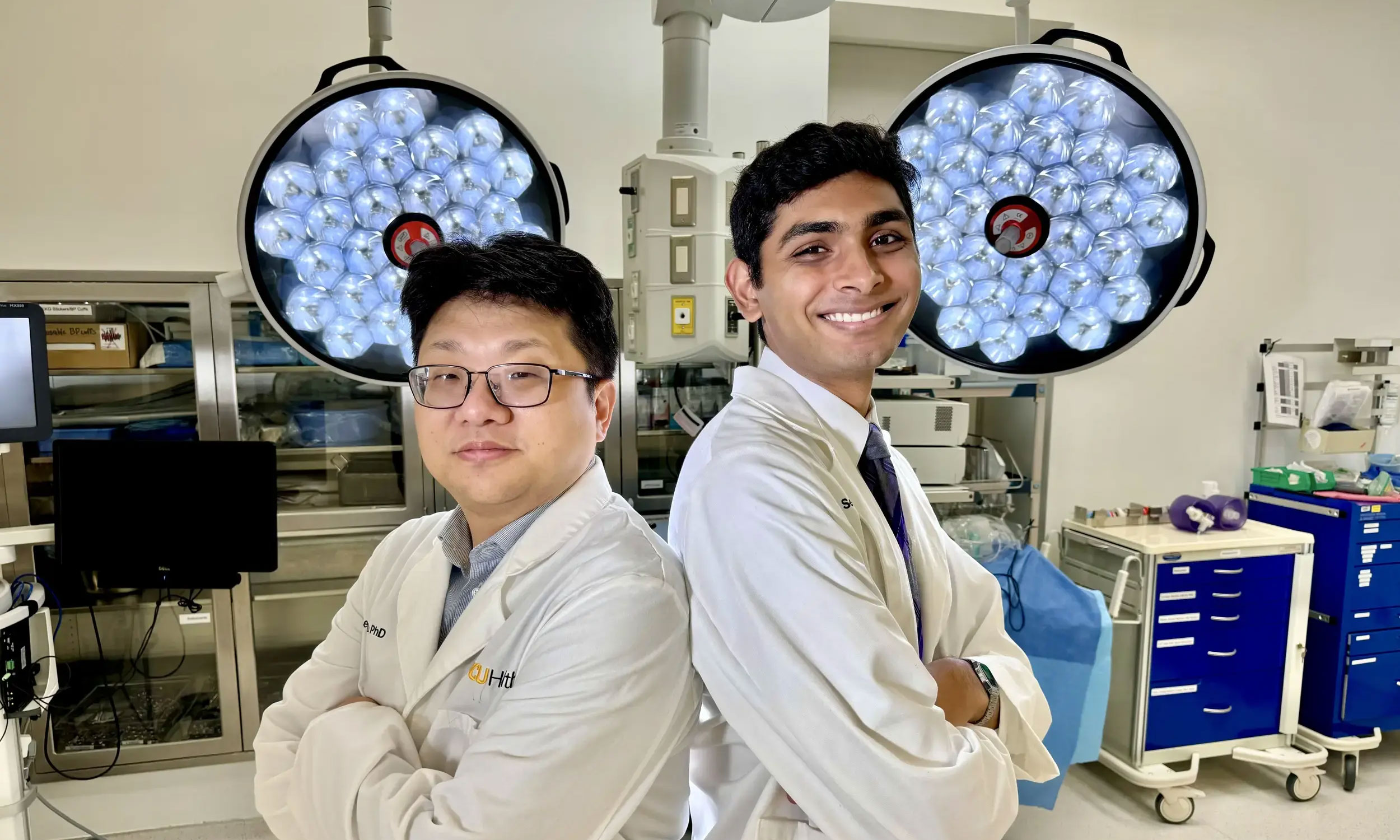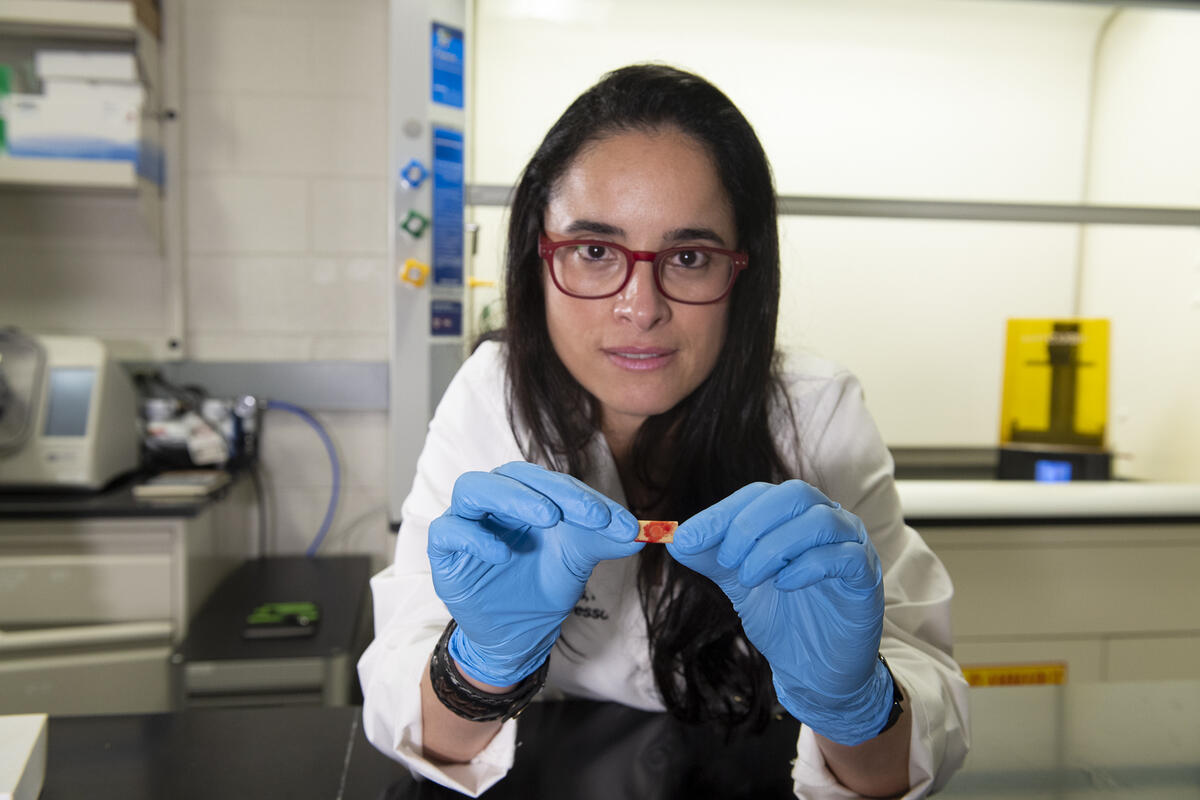From cancer to road safety, VCU innovators explore solutions with new round of funding

Spring 2024 grants from the Commercialization Fund aim to propel campus inventions into the marketplace.
By Dan Carrigan
Whether in the hospital or the laboratory, fighting HCC – one of the most aggressive forms of liver cancer – takes a team. Hepatocellular carcinoma currently stands as the fifth-most prevalent cancer in the world, according to Virginia Commonwealth University researchers in a study published in the Journal of Cancer Metastasis and Treatment this year.
Yet with research there is promise for new approaches, and a new one out of VCU has potential to treat the disease. Researchers at the VCU Health Hume-Lee Transplant Center are studying the use of targeted photodynamic therapy to treat HCC.
Here’s how the targeted PDT works: First, patients are injected with a well-known photosensitizer that has been repurposed for treatment, where it selectively accumulates in cancerous liver cells. Then, when exposed to a specific wavelength of light, the cancer cells die while leaving the healthy tissue unharmed.
“The idea that we have here is a very novel concept that uses light to deliver targeted therapy to the liver to treat the cancer,” said Kush Savsani, research assistant and incoming student at VCU School of Medicine, who is working under the direction of HCC researcher and Hume-Lee robotics surgeon Seung Duk Lee, M.D., Ph.D. Savsani was an Honors College student as an undergraduate at VCU.
Currently, the team is directing their efforts toward enhancing this treatment further while developing their own novel light delivery system, designed to target internal and highly vascular liver tumors. They want to refine how the light is delivered to ensure it reaches deep-seated tumors effectively. They also are exploring combining this treatment with other drugs, like the chemotherapy drug doxorubicin, to make it even more powerful against cancer.
“VCU is very unique,” Savsani said. “We have research staff and clinical staff working hand in hand. Because of that, we’re able to do pretty unique research that maybe other centers aren’t able to.”
Savsani, Lee and their team are one of six recipients of the spring 2024 round of Commercialization Fund awards from VCU TechTransfer and Ventures, part of the Office of the Vice President for Research and Innovation. The awards, which collectively total $242,000, support inventors who are conducting valuable translational research with a clear pathway to market.
“These initiatives embody the intersection of pioneering science and entrepreneurial vision, promising to revolutionize health care,” said P. Srirama Rao, Ph.D., VCU’s vice president for research and innovation. “Through our commitment to fostering innovation and collaboration, VCU continues to lead the way in advancing health care solutions that positively impact lives far beyond our campus.”
“We’re dedicated to empowering inventors and researchers to turn their ideas into tangible solutions that benefit society,” said Ivelina Metcheva, Ph.D., assistant vice president of innovation and head of TechTransfer and Ventures. “These recent awards are a testament to our belief in the power of innovation to drive positive change. By providing support and resources to these pioneering projects, we’re investing in the future of health care. Together, we’re forging new paths, pushing boundaries and shaping a world where innovation thrives and lives are transformed.”
In addition to Savsani and Lee, here are the five other projects and recipients of Commercialization Fund awards in the spring 2024 round:
***
Project: Steerable tandem applicator enhances precision in brachytherapy for cervical and uterine cancer.
Impact: Novel device offers customizable angles and multidirectional steering for improved radiation therapy, reducing complications.
Fund recipient: Navid Fallahi, M.D., radiation oncology clinical resident, Department of Radiation Oncology (School of Medicine).
Cervical and uterine cancers can be treated with internal radiation called brachytherapy. However, the variability in female anatomy, such as differences in uterine positioning, pose challenges for current rigid brachytherapy devices. These devices often do not conform well to individual patient anatomies, and that can lead to suboptimal radiation delivery and increased exposure to healthy tissues.
The VCU team has invented a flexible, steerable intracavitary brachytherapy applicator. This device features a jointed segment that allows the tip to be adjusted at various angles, accommodating individual patient anatomies. The design enables physicians to navigate and position the device precisely within the uterine cavity. It is also MRI-compatible, enhancing imaging capabilities during treatment planning.
Collaborations with manufacturing companies are underway to finalize the design and produce a testable prototype. The prototype would undergo rigorous testing in simulated environments to assess its performance, stability and radiation delivery accuracy. Future steps include refining the prototype based on testing feedback and conducting clinical trials to demonstrate its efficacy and safety.
The ultimate goal is to obtain FDA clearance, allowing for commercialization and widespread use — potentially revolutionizing brachytherapy procedures for gynecological cancers and extending its application to other cancers.
***
Project: At-home blood calcium sensor supports accurate chronic disease management.
Impact: New ion-selective optode technology enables high-precision electrolyte monitoring for patients outside clinical settings.
Fund recipient: Xuewei Wang, Ph.D., assistant professor, Department of Chemistry (College of Humanities and Sciences).
Wang and his team have developed an innovative at-home blood calcium sensor that addresses the limitations of current electrolyte monitoring methods. This novel sensor uses a colorimetric ion-selective liquid optode, capable of detecting calcium ions in just a few microliters of blood.
Electrolyte imbalances are a critical issue affecting various chronic diseases, including endocrine, renal, cardiac and hepatic disorders. Monitoring these imbalances is essential for managing conditions such as hypoparathyroidism, congestive heart failure and kidney failure.
Unlike glucose monitoring, which has become highly accessible with at-home devices, there are no user-friendly tools for patients to measure their blood electrolytes outside of clinical settings. Existing hospital-based blood gas/electrolyte analyzers are not suitable for home use due to their high cost and the large blood volume required for accurate measurements.
With a market clearly identified for calcium sensors and the potential applicability to other electrolytes, the VCU researchers hope to revolutionize chronic disease management by offering high-precision, user-friendly home monitoring solutions.
***
Project: Method for muscular dystrophy progression assessment uses blood samples.
Impact: Innovative cell analysis technique offers noninvasive monitoring for disease severity evaluation.
Fund recipient: Christopher Ehrhardt, Ph.D., professor, Department of Forensic Science (College of Humanities and Sciences).
Myotonic dystrophy (DM) is a genetic muscular dystrophy characterized by progressive muscle weakness and muscle degeneration. Diagnosis and monitoring of DM relies on muscle biopsies and genetic assays that can be invasive and sometimes unreliable. Current genetic assays do not consistently correlate with symptom severity.
To address this, Ehrhardt and Amanda Gentry, Ph.D., have developed a novel method for stratifying DM patients. Using their technique, they can study the progression of disease and classify patients from a single drop of plasma. Ultimately, they aim to provide a reliable, noninvasive diagnostic tool that improves patient care and accelerates clinical trials for DM therapies.
***
Project: Refinement and assessment of machine-learning protocols for health care diagnostics.
Impact: Advancements in evaluation techniques drive progress in medical applications.
Fund recipient: Thomas D. Roper, Ph.D., director of pharmaceutical engineering and Engineering Foundation Professor, Department of Chemical and Life Science Engineering (College of Engineering).
A VCU team is developing a machine-learning process to build better predictive models for types of continuous datasets. This has particular use in health care as software for the analysis of spectroscopic data, which examines how matter interacts with light, and epigenetics data that studies changes in gene expression that do not involve alterations to the underlying DNA sequence.
The project aims to address the need for more efficient and noninvasive methods of disease monitoring and diagnostics. Traditional methods often involve invasive procedures or can be time-consuming, leading to delays in diagnosis and treatment.
The research is led by Roper along with Ph.D. candidate Matthew Glace and Roudabeh Moazeni, Ph.D. By using advanced analytical techniques and optimizing algorithm processes, they seek to develop a commercial diagnostics platform that can handle complex datasets efficiently. Ultimately, their goal is to improve patient outcomes and contribute to the advancement of precision medicine on a global scale.
***
Project: Novel THC breathalyzer advances cannabis impairment detection.
Impact: Colorimetric technology enables real-time analysis of delta 9-THC levels in exhaled air for enhanced road safety.
Fund recipient: Emanuele Alves, Ph.D., assistant professor, Department of Forensic Science (College of Humanities and Sciences).

The project aims to develop a THC breathalyzer utilizing colorimetric detection technology, addressing the growing concern over cannabis-impaired driving. Currently, there is a lack of efficient, noninvasive methods for detecting delta 9-THC, the psychoactive component of cannabis, in drivers. To fill this gap, the team led by Alves is developing a cartridge-based system for collecting exhaled air and analyzing THC content in real time.
A dye in the cartridge reacts to the delta 9-THC, producing a specific color that will confirm THC within the critical window of up to two hours after cannabis use — crucial for roadside testing. The team is now working to validate the cartridge’s ability to differentiate between delta 9-THC and other cannabinoids like CBD, which is nonpsychoactive.
Once completed, the THC breathalyzer could be a valuable tool for law enforcement agencies and public safety stakeholders in detecting cannabis impairment on the roads.
Categories Chemical & Life Science Engineering, Faculty Awards, Research Grants